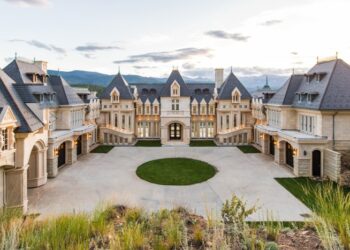Delving into the rich world of Spanish interior design, this article will uncover the key characteristics, traditional elements, modern interpretations, architectural features, and furniture styles that define this captivating aesthetic. From vibrant color palettes to intricate patterns, get ready to be inspired by the beauty of Spanish design.
Overview of Spanish Interior Design
Spanish interior design is characterized by a blend of rich history, vibrant colors, intricate patterns, and ornate details. It reflects the diverse cultural influences that have shaped Spain over the centuries.
Key Characteristics of Spanish Interior Design
- Earthy and warm color palette, including terracotta, deep reds, blues, and yellows.
- Use of traditional materials like wrought iron, wood, and ceramic tiles.
- Intricate patterns and textures inspired by Moorish, Baroque, and Renaissance influences.
- Handcrafted furniture and decor pieces with ornate detailing.
- Integration of outdoor spaces like patios and courtyards into the interior design.
Cultural Influences on Spanish Interior Design
Spanish interior design is heavily influenced by the country's diverse history, including Moorish, Roman, and Gothic influences. The intricate patterns and vibrant colors reflect the vibrant culture of Spain.
Color Palette in Spanish Interior Design
The color palette commonly used in Spanish interior design includes warm earth tones like terracotta, deep reds, blues, and yellows. These colors evoke the Mediterranean landscape and add a sense of warmth and coziness to the space.
Traditional Elements in Spanish Interior Design
In traditional Spanish interior design, several key elements are commonly used to create a warm and inviting atmosphere. These elements often reflect the rich history and cultural influences of Spain.
Materials like Wrought Iron, Terracotta, and Ceramic Tiles
In Spanish interior design, materials such as wrought iron, terracotta, and ceramic tiles play a significant role in adding character and charm to the space. Wrought iron is often used for decorative elements like light fixtures, stair railings, and furniture accents.
Terracotta tiles are a staple in Spanish interiors, bringing a rustic and earthy feel to floors and walls. Ceramic tiles, known for their vibrant colors and intricate patterns, are frequently used in kitchens, bathrooms, and as decorative accents throughout the home.
Intricate Patterns like Arabesque and Floral Motifs
Spanish interior design is known for its use of intricate patterns inspired by Moorish and Mediterranean influences. Arabesque patterns, characterized by geometric shapes and intricate designs, are commonly found in textiles, rugs, and wall decor. Floral motifs, often featuring vibrant colors and delicate details, are another prevalent design element in Spanish interiors, adding a touch of elegance and femininity to the space.
Handcrafted Furniture and Textiles
Handcrafted furniture and textiles play a vital role in traditional Spanish interiors, showcasing the artistry and craftsmanship of local artisans. Hand-carved wooden furniture, upholstered in rich fabrics like velvet or leather, adds warmth and sophistication to living spaces. Textiles like embroidered linens, intricate lacework, and colorful tapestries are used to adorn furniture, windows, and walls, bringing texture and personality to the room.
Modern Interpretations of Spanish Interior Design
In recent years, there has been a growing trend towards modern interpretations of Spanish interior design, blending traditional elements with contemporary styles to create unique and sophisticated spaces.
Comparison of Traditional vs. Modern Spanish Interior Design
Traditional Spanish interior design is characterized by rich colors, ornate details, and intricate patterns, reflecting the country's history and culture. On the other hand, modern Spanish interior design often incorporates clean lines, minimalistic furnishings, and a more neutral color palette, giving a fresh and updated look to the space.
Integration of Contemporary Elements in Spanish Interiors
Contemporary elements such as sleek furniture, geometric shapes, and innovative lighting fixtures are seamlessly integrated into Spanish interiors to add a touch of modernity while still honoring the traditional roots of the design. This fusion creates a harmonious balance between old-world charm and contemporary sophistication.
Fusion of Minimalism and Spanish Design Aesthetics
The fusion of minimalism and Spanish design aesthetics in modern spaces results in clean and uncluttered interiors that highlight the beauty of architectural details and natural materials. By incorporating minimalist principles, such as simplicity and functionality, Spanish interior design achieves a modern look that is both elegant and timeless
Architectural Features in Spanish Interior Design
Spanish interior design is characterized by unique architectural features that play a crucial role in defining the overall aesthetic of the space. From arches and exposed wooden beams to intricate tile work, these elements contribute to the charm and authenticity of Spanish homes.
Importance of Arches, Exposed Wooden Beams, and Tile Work
In Spanish interior design, arches are not just structural elements but also serve as decorative features that add a sense of grandeur and elegance to the space. These architectural arches are often seen in doorways, windows, and passageways, creating a sense of flow and continuity throughout the home.
Exposed wooden beams, on the other hand, bring a rustic and cozy feel to the interiors, adding warmth and character to the space. Lastly, tile work, such as colorful mosaic tiles or intricate patterns, is a hallmark of Spanish design, often used in flooring, backsplashes, and accent walls to infuse a touch of Mediterranean flair.
Significance of Courtyards, Patios, and Balconies
Courtyards, patios, and balconies are integral parts of Spanish architecture, serving as outdoor extensions of the interior living spaces. Courtyards, known as "patios" in Spanish, are typically enclosed outdoor spaces surrounded by the walls of the house, providing privacy and a tranquil retreat for residents.
Patios are often adorned with lush greenery, fountains, and seating areas, creating a peaceful oasis in the heart of the home. Balconies, on the other hand, offer panoramic views of the surroundings and serve as charming outdoor spaces for relaxation and social gatherings.
Maximizing Natural Light
One of the key design principles in Spanish interiors is the maximization of natural light. To achieve this, architects and designers strategically place windows, doors, and openings to allow sunlight to flood the space. High ceilings, light-colored walls, and reflective surfaces are also used to bounce light around the room, creating a bright and airy atmosphere.
Additionally, skylights and glass doors are commonly integrated into Spanish homes to bring in more natural light and blur the boundaries between indoor and outdoor living spaces.
Furniture and Decor in Spanish Interior Design
Spanish interior design is known for its unique furniture pieces and decorative elements that add character and warmth to spaces. Let's explore some key aspects of furniture and decor in Spanish interiors.
Iconic Spanish Furniture Pieces
In Spanish interior design, iconic furniture pieces like the Barcelona chair designed by Mies van der Rohe are highly coveted. These pieces often feature a blend of traditional craftsmanship with modern design elements, creating a timeless appeal in Spanish interiors.
Textiles in Spanish Interiors
Textiles play a crucial role in adding warmth and texture to Spanish interiors. Rugs, tapestries, and curtains featuring intricate patterns and rich colors are commonly used to enhance the overall aesthetic of a space. These textiles not only provide visual interest but also contribute to the cozy atmosphere that Spanish interiors are known for.
Decorative Elements in Spanish Interiors
In addition to furniture and textiles, decorative elements like ceramics, wrought iron fixtures, and pottery are integral to Spanish interior design. These pieces often showcase traditional Spanish craftsmanship and add a rustic charm to the space. From colorful ceramic tiles to ornate wrought iron light fixtures, these decorative elements bring a touch of authenticity and heritage to Spanish interiors.
Closing Summary
In conclusion, Spanish interior design offers a unique blend of history, culture, and innovation. Whether you prefer the traditional warmth of handcrafted furniture or the sleek lines of modern interpretations, Spanish design has something for every taste. Embrace the charm and elegance of Spanish interiors to create a space that is truly timeless and inviting.
Essential FAQs
What are the key characteristics of Spanish interior design?
Spanish interior design is known for its vibrant color palettes, intricate patterns, and a mix of traditional and modern elements that create a warm and inviting atmosphere.
How do cultural influences shape Spanish interior design?
Cultural influences, such as Moorish and Mediterranean styles, play a significant role in shaping Spanish interior design, seen in the use of materials, patterns, and architectural features.
What are some traditional elements commonly found in Spanish interior design?
Traditional Spanish interiors often feature materials like wrought iron, terracotta, and ceramic tiles, along with intricate patterns like arabesque and floral motifs.
How does natural light play a role in Spanish interior design?
Natural light is maximized in Spanish interiors through design elements like arches, courtyards, and balconies, creating bright and airy spaces that reflect the Mediterranean lifestyle.





